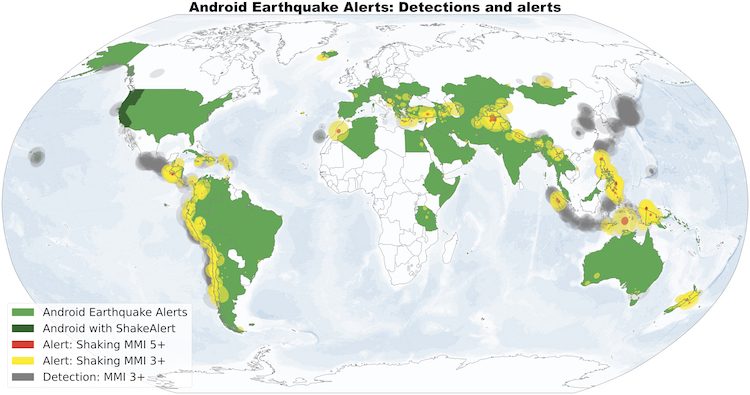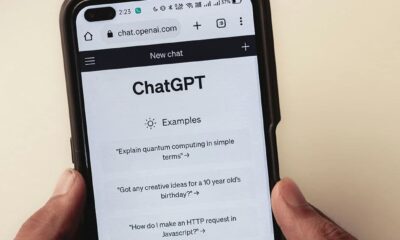Science
Android Phones Transform Earthquake Alerts with Global Network

The global network of Android smartphones has been harnessed to create an effective early warning system for earthquakes, granting users critical seconds to react before tremors begin. This innovative approach is the result of a comprehensive three-year study conducted by researchers at Google, the parent organization of Android, and encompasses data from millions of devices across 98 countries.
According to study co-leader Richard Allen, who is also a faculty researcher at Google and directs the Berkeley Seismological Laboratory at the University of California, Berkeley, the Android Earthquake Alert (AEA) system has the potential to deliver life-saving warnings in regions that currently lack established early warning infrastructures. “By using Android smartphones, which account for approximately 70% of the global smartphone market, we can provide vital alerts in many parts of the world,” Allen stated.
Traditional earthquake early warning systems rely on specialized seismic sensors strategically placed to detect seismic activity. These systems have been successfully implemented in countries such as Mexico, Japan, and Taiwan, as well as in South Korea, Israel, Costa Rica, and Canada. They can swiftly identify earthquakes near the epicenter and issue warnings to surrounding areas. Even a brief warning can prompt individuals to take protective measures, such as the widely recommended “drop, cover, and hold on” (DCHO) procedure.
Establishing these traditional seismic networks can be prohibitively expensive, leaving many earthquake-prone areas without adequate protection. In contrast, most smartphones are equipped with built-in accelerometers. As the popularity of these devices surged during the 2010s, seismologists began to explore their potential for earthquake detection. “While the accelerometers in smartphones are less sensitive than those in permanent seismic monitoring stations, they are still capable of detecting tremors during significant seismic events,” Allen explained.
The development of smartphone-based earthquake detection has evolved since the late 2010s. Several applications, such as Mexico’s SkyAlert and Berkeley’s ShakeAlert, have emerged to sense seismic activity in real time. The most recent study enhances these efforts by utilizing smartphone accelerometers as a collective seismic array. “This allows us to provide warnings in underserved regions where early alerts were previously unavailable,” Allen noted.
Between 2021 and 2024, Allen and his colleague, Marc Stogaitis, a principal software engineer at Android, tested the AEA system. The results were significant, as the application detected an average of 312 earthquakes each month, with magnitudes ranging from 1.9 to 7.8, correlating to notable seismic events in Japan and Türkiye, respectively.
For earthquakes measuring 4.5 or higher, the system issued “TakeAction” alerts, prompting users to react immediately. During the study, an average of 60 such alerts were sent monthly, reaching approximately 18 million individual notifications. Additionally, the system provided “BeAware” alerts for regions anticipated to experience shaking intensity levels of 3 or 4.
To evaluate the effectiveness of these alerts, the researchers utilized Google Search to gather voluntary feedback through user surveys. From February 5, 2023, to April 30, 2024, over 1,555,006 individuals responded to surveys after receiving AEA-generated alerts. Results revealed that 85% of respondents felt ground movement, with 36% receiving alerts before the shaking began, 28% during, and 23% afterward.
The AEA operates on principles similar to those of traditional seismic detection systems. When an Android smartphone remains stationary, its accelerometer detects acceleration patterns consistent with P and S waves produced by earthquakes. Upon identifying these patterns, the device transmits acceleration data and an approximate location to Google servers. The servers then assess potential seismic sources that align with this data.
“When a candidate earthquake source meets the observed data with sufficient confidence, an earthquake is declared, and its magnitude, hypocenter, and origin time are estimated based on the arrival time and amplitude of the P and S waves,” Stogaitis explained. This detection capability is integrated into Google Play Services, making it readily available by default on most Android devices. Given the billions of Android smartphones in circulation, this system offers earthquake detection capabilities in both affluent and less-wealthy nations.
Looking ahead, Allen and his team aspire to leverage the data gathered to develop additional tools for hazard mitigation. For instance, maps illustrating ground shaking could enhance emergency response efforts following seismic events. Currently, the researchers, whose findings are published in Science, are focused on refining the AEA system. “We are continuously learning from earthquakes as they occur around the globe, and the Android Earthquake Alerts system is helping us collect information about these natural disasters rapidly,” Allen remarked. “We believe we can further enhance the quality of earthquake detections and improve our strategies for delivering effective alerts.”
-

 World2 weeks ago
World2 weeks agoCoronation Street’s Shocking Murder Twist Reveals Family Secrets
-

 Entertainment1 week ago
Entertainment1 week agoAndrew Pierce Confirms Departure from ITV’s Good Morning Britain
-

 Entertainment5 months ago
Entertainment5 months agoKate Garraway Sells £2 Million Home Amid Financial Struggles
-

 Entertainment4 months ago
Entertainment4 months agoAnn Ming Reflects on ITV’s ‘I Fought the Law’ Drama
-

 Entertainment1 month ago
Entertainment1 month agoCoronation Street Fans React as Todd Faces Heartbreaking Choice
-

 Health4 months ago
Health4 months agoKatie Price Faces New Health Concerns After Cancer Symptoms Resurface
-

 World1 month ago
World1 month agoBailey Announces Heartbreaking Split from Rebecca After Reunion
-

 Entertainment2 weeks ago
Entertainment2 weeks agoTwo Stars Evicted from I’m A Celebrity Just Days Before Finale
-

 Entertainment4 months ago
Entertainment4 months agoCoronation Street’s Carl Webster Faces Trouble with New Affairs
-

 World2 weeks ago
World2 weeks agoKevin Sinfield Exceeds Fundraising Goal Ahead of Final Marathons
-

 Entertainment4 months ago
Entertainment4 months agoWhere is Tinder Swindler Simon Leviev? Latest Updates Revealed
-

 Entertainment5 months ago
Entertainment5 months agoMarkiplier Addresses AI Controversy During Livestream Response





















